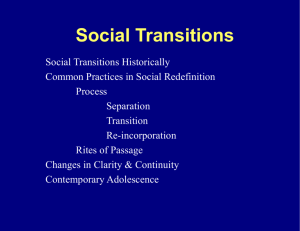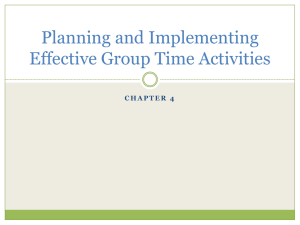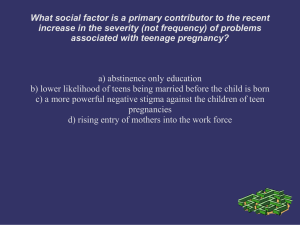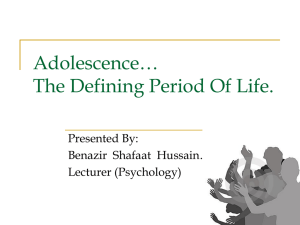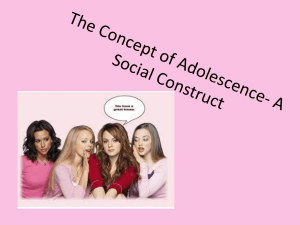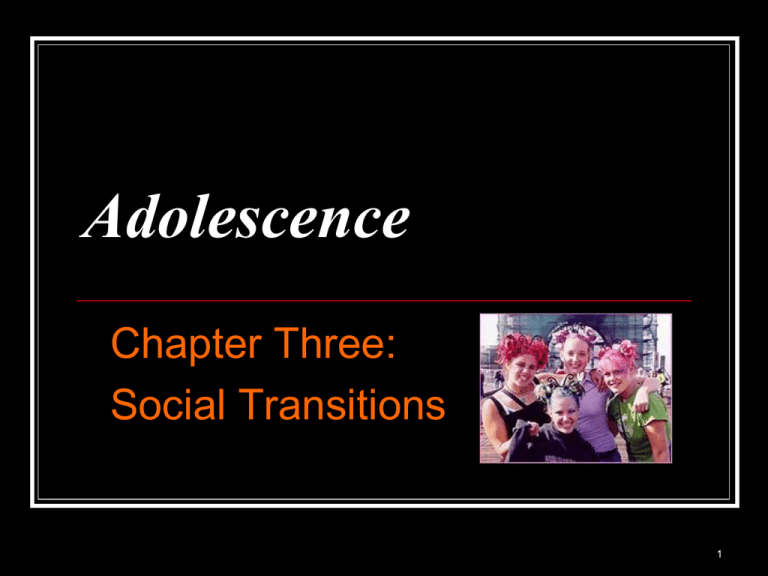
Adolescence
Chapter Three:
Social Transitions
1
Questions…
Are Social Transitions as important in
defining Adolescence as the Biological and
Cognitive changes already discussed?
Why?
2
Social Redefinition
In all societies adolescence is a period of
social transition for the individual
The individual comes to be recognized as
an adult
The social transition is less explicit in
contemporary U.S. society than in
traditional cultures
3
Social Redefinition
and Psychosocial Development
Identity
attainment of adult status causes adolescent to
feel more adultlike
Development of Autonomy
Adult status leads to shifts in responsibility,
independence, and freedom
Permitted to make decisions that have long-term
consequences
4
Social Redefinition
and Psychosocial Development
Age of majority: legal age for adult status
Interest in intimacy, dating and marriage
Need for new and different decisions about
sexual activity
Achievement
Becoming a full-time employee
Permitted to leave school on their own volition
5
Adolescence as a Social
Invention
Question:
What is the Inventionist perspective on
Adolescence?
What evidence would you use to support it
and what would you use to argue against it?
6
Adolescence as a Social Invention
Adolescence defined primarily by
societal distinction of this period from
childhood or adulthood
Inventionists stress that because we see
adolescence as distinct, it exists as such
7
Adolescence as a Social Invention
Roots in the Industrial Revolution
Young people excluded from labor force
Economic dependence on elders
Formal schooling is lengthened
New Terminology
Teenager
Youth
Emerging adulthood
8
Changes in Status
Two-sided alteration in status
Given privileges/rights reserved for
society’s adults
Increased expectations for
self-management
personal responsibility
social participation
9
Changes in Interpersonal Status
Addressed with adult titles
Maintain new types of social relationships
with
Parents
Elders
Younger individuals whose status has not yet
changed
10
Changes in Political Status
Permission for more extensive participation
in the community’s decision making
Voting (U.S. citizens)
Ceremonial life (Navaho people)
Expected to serve their communities in
emergency and train for warfare
11
Changes in Economic Status
May own property and maintain control
over their income
Age is a prerequisite for employment in
certain occupations
Expected to contribute to the economic
well-being of their community, i.e. pay
taxes
12
Changes in Legal Status
Ability to participate in activities typically
reserved for adults
gambling, purchasing alcoholic beverages, and
driving
Expected to take increased responsibility for
self-management and social participation
13
The Process of Social Redefinition
A series of events occurring over time
Contemporary America
Generally begins at age 15 or 16
Permission to drive, work, leave school
Voting, age 18
Purchasing alcoholic beverages, age 21
14
The Process of Social Redefinition
Social redefinition often occurs in cohort groups
High school graduating class
Quinceañera celebrations
Fraternity/sorority pledge groups
Timetable is affected by economics, politics and
culture
Can you think of other traditions that promote this
social redefinition or introduction to society as an
adult?
15
Are these rites of passage?
16
The Process of Social Redefinition
Some societies mark social redefinition of
the young person with a dramatic and
elaborate initiation ceremony
This usually marks the beginning of a long
period of training
Anyone have any personal examples?
17
Social Redefinition:
General Themes
(1)
(2)
(3)
Extrusion
Real or symbolic separation from parents
Separation of males and females in adolescence
due to physical changes
►brother-sister avoidance
Passing on of cultural, historical, and practical
information from the adult generation to the newlyinducted cohort of young people
18
Two dimensions that can differ in the
process of social redefinition…
Clarity: explicitness of the transition
Continuity: smoothness of transition
19
Variations in Social Transitions:
Clarity in Industrialized Societies
Not much clarity: no universal formal initiation
ceremonies; no unified transitions of cohorts
(eg: all graduation, start work, marry at same
time)
Given the absence of clarity
People of the same chronological age may feel more
mature or less mature than agemates
Highest level of problem behaviors in
Adolescent boys who felt markedly older than their
actual age
21
Variations in Social Transitions:
Clarity in Traditional Cultures
Social redefinition is clearly recognized
Formal initiation ceremony
Boys: timing of ceremony varies
Girls: timing usually linked to menarche
Physical appearance is often changed
Adults clearly differentiated from children
22
Variations in Social Transitions:
Clarity in Previous Eras
U.S. transition to adulthood in the early 19th
century was more disorderly
School – viewed as children
Work – viewed as adults
Timetable depended on household/family needs
A century ago, the passage into adulthood may
have been more prolonged than today.
SO, although currently transitions not very clear;
better than before…
23
Variations in Social Transitions:
Continuity
Continuous transitions
Gradual transitions, where the adolescent
assumes the roles and status of adulthood bit by
bit
Discontinuous transitions
Sudden transitions,where the adolescent’s
entrance into adulthood is more abrupt, with little
or no training
24
Variations in Social Transitions:
Continuity
Contemporary Society - discontinuous
Little preparation for roles of worker, parent,
citizen
Call to improve “school-to-work transition”
A non-college route?
Youth apprenticeship
Traditional Cultures
Previous Eras
25
The Transition into Adulthood in
Contemporary Society
Two trends are reshaping the transition
(1) The transition period is getting longer
Puberty occurs earlier and schooling lasts
longer.
(2) Success in the labor force is more
dependent on formal schooling
26
Special Transitional Problems of
Poor and Minority Youth
Foreign born adolescent immigrants have
better mental health, less problem behaviors,
perform better in school than same ethnic
group, but born here in U.S.
“Americanization” associated with worse
outcomes (compared to immigrants)
Many factors involved including poverty, discrimination,
and segregation
Experiencing poverty during adolescence has an
especially negative effect on school achievement
27
What Can Be Done
to Ease the Transition?
Restructuring secondary education
Expanding work and volunteer
opportunities
Improving the quality of community life for
adolescents and their parents
Expanded opportunities in the workplace to
make high school a “bridge”
28
What Can Be Done
to Ease the Transition?
Encouragement to spend time in voluntary,
nonmilitary service activities
Staffing day-care centers
Working with the elderly
Mentoring programs for at-risk adolescents,
who often have few relationships with
positive adult role models
29
The Influence of Neighborhood
Conditions on Adolescent Development
Adolescents growing up in poor, urban
communities are more likely than peers
from equally poor households in better
neighborhoods to
Bear children as teenagers
Become involved in criminal activities
Achieve less in or drop out of high school
WHY?
30
How might Neighborhood Conditions
Affect Adolescent Development?
Three possible mechanisms
(1) Lack of collective efficacy
(2) Stresses associated with poverty undermine the
quality of interpersonal relationships
(3) Fewer chances to engage in activities that
facilitate positive development; fewer resources
available during difficult times
31

